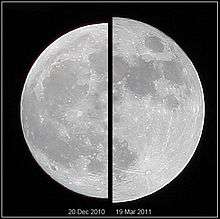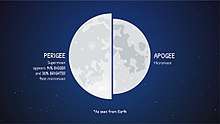Supermoon

A supermoon is a full moon or a new moon that approximately coincides with the closest distance that the Moon reaches to Earth in its elliptic orbit, resulting in a slightly larger-than-usual apparent size of the lunar disk as seen from Earth.[1] The technical name is the perigee syzygy of the Earth–Moon–Sun system or more simply full (or new) Moon at perigee.[lower-alpha 1] The term supermoon is astrological in origin and has no precise astronomical definition.[2]
The real association of the Moon with both oceanic and crustal tides has led to claims that the supermoon phenomenon may be associated with increased risk of events like earthquakes and volcanic eruptions, but no such link has been found.[3]
The opposite phenomenon, an apogee syzygy, has been called a micromoon.[4]
Definitions
The name supermoon was coined by astrologer Richard Nolle in 1979, in Dell Horoscope magazine arbitrarily defined as:
... a new or full moon which occurs with the Moon at or near (within 90% of) its closest approach to Earth in a given orbit (perigee). In short, Earth, Moon and Sun are all in a line, with Moon in its nearest approach to Earth.
— Richard Nolle[5]

He came up with the name while reading “Strategic Role Of Perigean Spring Tides in Nautical History and Coastal Flooding” published in 1976 by NOAA Hydrologist Fergus Wood.[6][7] Nolle never outlined why he chose 90%,[2] but explained in 2011 that he based calculations on 90% of the difference in lunar apsis extremes for the solar year. In other words, a full or new moon is considered a supermoon if where is the lunar distance at syzygy, is the lunar distance at apogee, and is the lunar distance at perigee.[8][9]
In practice, there is no official or even consistent definition of how near perigee the full Moon must occur to receive the supermoon label, and new moons rarely receive a supermoon label. Sky and Telescope magazine refers to full Moon which comes within 223,000 miles (359,000 km), TimeandDate.com prefers a definition of 360,000 kilometres (220,000 mi). EarthSky uses Nolle's definition comparing their calculations to tables published by Nolle in 2000.[10][11]
The term perigee-syzygy or perigee full/new moon is preferred in the scientific community.[12] Perigee is the point at which the Moon is closest in its orbit to the Earth, and syzygy is when the Earth, the Moon and the Sun are aligned, which happens at every full or new moon. Astrophysicist Fred Espenak uses Nolle's definition but preferring the label of full Moon at perigee.[13] Wood used the definition of a full or new moon occurring within 24 hours of perigee and also used the label perigee-syzygy.[7]
Wood also coined the less used term proxigee where perigee and the full or new moon are separated by 10 hours or less.[7]
Occurrence
Of the possible 12 or 13 full (or new) moons each year, usually three or four may be classified as supermoons, as commonly defined.
The most recent full supermoon occurred on January 31, 2018, and the next one will be on December 22, 2018.[13] The one on November 14, 2016 was the closest full supermoon since January 26, 1948, and will not be surpassed until November 25, 2034.[14] The closest full supermoon of the 21st century will occur on December 6, 2052.[15]

The oscillating nature of the distance to the full or new moon is due to the difference between the synodic and anomalistic months.[13] The period of this oscillation is roughly 14 synodic months.
Occasionally, a supermoon coincides with a total lunar eclipse. The most recent occurrence of this was in January 2018, and the next will be in January 2019.[16]
Appearance
.jpg)
A full moon at perigee appears roughly 14% larger in diameter than at apogee.[17] Many observers insist that the moon looks bigger to them. This is likely due to observations shortly after sunset when Moon is near the horizon and the moon illusion is at its most apparent.[18]
While the moon's surface luminance remains the same, because it is closer to the earth the illuminance is about 30% brighter than at its farthest point, or apogee. This is due to the inverse square law of light which changes the amount of light received on earth in inverse proportion to the distance from the moon.[19] While a typical summer full moon at temperate latitudes provides only about 0.05-0.1 lux, a supermoon directly overhead in the tropics could provide up to 0.36 lux.[20]
Effects on Earth
Claims that supermoons can cause natural disasters, and the claim of Nolle that supermoons cause "geophysical stress", have been refuted by scientists.[21][22][23][24]
Despite lack of scientific evidence, there has been media speculation that natural disasters, such as the 2011 Tōhoku earthquake and tsunami and the 2004 Indian Ocean earthquake and tsunami, are causally linked with the 1–2 week period surrounding a supermoon.[25][26] A large, 7.5 magnitude earthquake centred 15 km north-east of Culverden, New Zealand at 00:03 NZDT on November 14, 2016, also coincided with a supermoon.[27][28]
Scientists have confirmed that the combined effect of the Sun and Moon on the Earth's oceans, the tide,[29] is greatest when the Moon is either new or full.[30] and that during lunar perigee, the tidal force is somewhat stronger,[31] resulting in perigean spring tides. However, even at its most powerful, this force is still relatively weak,[32] causing tidal differences of inches at most.[33]
Notes
References
- ↑ Staff (September 7, 2014). "Revisiting the Moon". New York Times. Retrieved September 8, 2014.
- 1 2 Phil Plait. "Kryptonite for the supermoon". Bad Astronomy. Discover. Retrieved August 29, 2015.
- ↑ Rachel Rice. "No Link Between 'Super Moon' and Earthquakes". Discovery News. Retrieved March 20, 2015.
- ↑ "What Is a Micromoon?". Timeanddate.com. Stavanger, Norway: Time and Date AS. n.d. Retrieved August 6, 2018.
- ↑ Nolle, Richard. "Supermoon". Astropro (No publication date; modified March 10, 2011). Retrieved 14 March 2011.
- ↑ "What is a Super Moon". Actforlibraries.org. Retrieved 2018-01-10.
- 1 2 3 Fergus, Wood (1976). The Strategic Role of Perigean Spring Tides in Nautical History and Coastal Flooding, 1635-1976. Washington DC: NOAA.
- ↑ "November 2017 full moon a supermoon? | EarthSky.org". earthsky.org. Retrieved 2018-01-08.
- ↑ Nolle, Richard. "SuperMoon: What It Is, What It Means". www.astropro.com. Retrieved 2018-01-08.
- ↑ "November 2017 full moon a supermoon? | EarthSky.org". earthsky.org. Retrieved 2018-01-08.
- ↑ Nolle, Richard. "Astrologer Richard Nolle's Century 21 CE SuperMoon Table". www.astropro.com. Retrieved 2018-01-08.
- ↑ Phillips, Tony (May 2, 2012). "Perigee "Super Moon" On May 5–6". NASA Science News. NASA. Retrieved 6 May 2012.
- 1 2 3 Espenak, Fred. "Full Moon at Perigee (Super Moon): 2001 to 2100". astropixels.com. Retrieved 2018-01-10.
- ↑ "What is a supermoon?". Retrieved 14 November 2016.
- ↑ "Closest supermoon since 1948!". EarthSky. Retrieved 14 November 2016.
- ↑ "Missed the super blue blood moon eclipse? Here's when you'll see the next one. Including a Lunar Eclipse". Elizabeth Howell at Space.com. 2 December 2017. Retrieved 2 December 2017.
- ↑ "Supermoon 2018: When and How to See January's Two Full Moons". Space.com. Retrieved 2018-01-10.
- ↑ "What Is A Supermoon? Facts vs. Fiction - Sky & Telescope". Sky & Telescope. 2016-11-08. Retrieved 2018-01-10.
- ↑ Phillips, Tony (March 16, 2011). "Super Full Moon". Science@NASA Headline News. NASA. Archived from the original on May 7, 2012. Retrieved 22 June 2013.
- ↑ Kyba, Christopher C M; Mohar, Andrej; Posch, Thomas (1 February 2017). "How bright is moonlight?". Astronomy & Geophysics. 58 (1): 1.31–1.32. doi:10.1093/astrogeo/atx025.
- ↑ "Kryptonite for the supermoon - Bad Astronomy". Bad Astronomy. 2011-03-18. Retrieved 2018-01-07.
- ↑ "Can the position of the Moon affect seismicity?". The Berkeley Seismological Laboratory. 1999. Retrieved 14 March 2011.
- ↑ Fuis, Gary. "Can the position of the moon or the planets affect seismicity?" (No publication date). U.S. Geological Survey: Earthquake Hazards Program. Archived from the original on 7 May 2011. Retrieved 14 March 2011.
- ↑ Wolchover, Natalie (March 9, 2011). "Will the March 19 "SuperMoon" Trigger Natural Disasters?". Life's Little Mysteries. Retrieved 15 March 2011.
- ↑ Paquette, Mark (March 1, 2011). "Extreme Super (Full) Moon to Cause Chaos?". Astronomy Weather Blog. AccuWeather. Retrieved 14 March 2011.
- ↑ "Is the Japanese earthquake the latest natural disaster to have been caused by a supermoon?". The Daily Mail. March 11, 2011. Retrieved 14 March 2011.
- ↑ "GeoNet - Quakes". Retrieved 13 November 2016.
- ↑ Andrew Griffin. "Supermoon: Biggest in living memory to appear in the sky, as 2016 ends with three huge full moons in a row". The Independent.
- ↑ Plait, Phil (2008). "Tides, the Earth, the Moon, and why our days are getting longer". Bad Astronomy (Modified March 5, 2011). Retrieved 14 March 2011.
- ↑ Sumich, J.L. (1996). "Animation of spring and neap tides". NOAA's National Ocean Service. Retrieved June 22, 2013.
- ↑ "Apogee and Perigee of the Moon". Moon Connection (No publication date). Retrieved 14 March 2011.
- ↑ Plait, Phil (March 11, 2011). "No, the 'supermoon' didn't cause the Japanese earthquake". Discover Magazine. Retrieved 14 March 2011.
- ↑ Rice, Tony (4 May 2012). "Super moon looms Saturday". WRAL-TV. Retrieved 5 May 2012.
External links
| Look up supermoon in Wiktionary, the free dictionary. |
![]()
